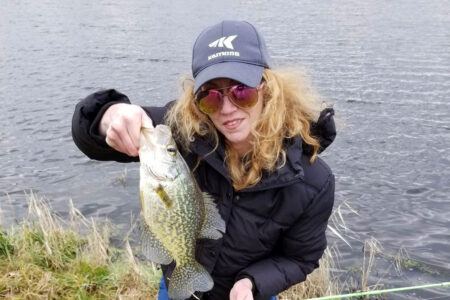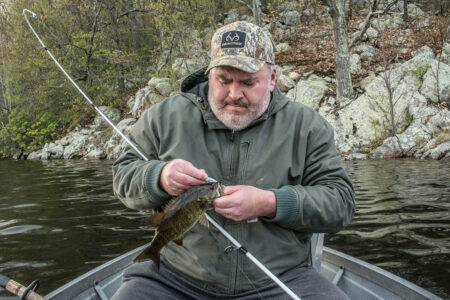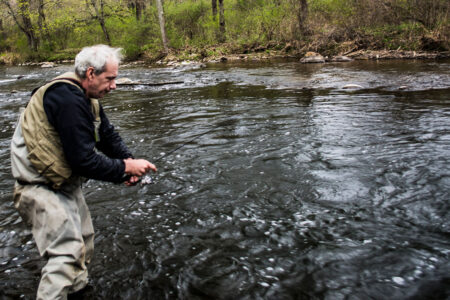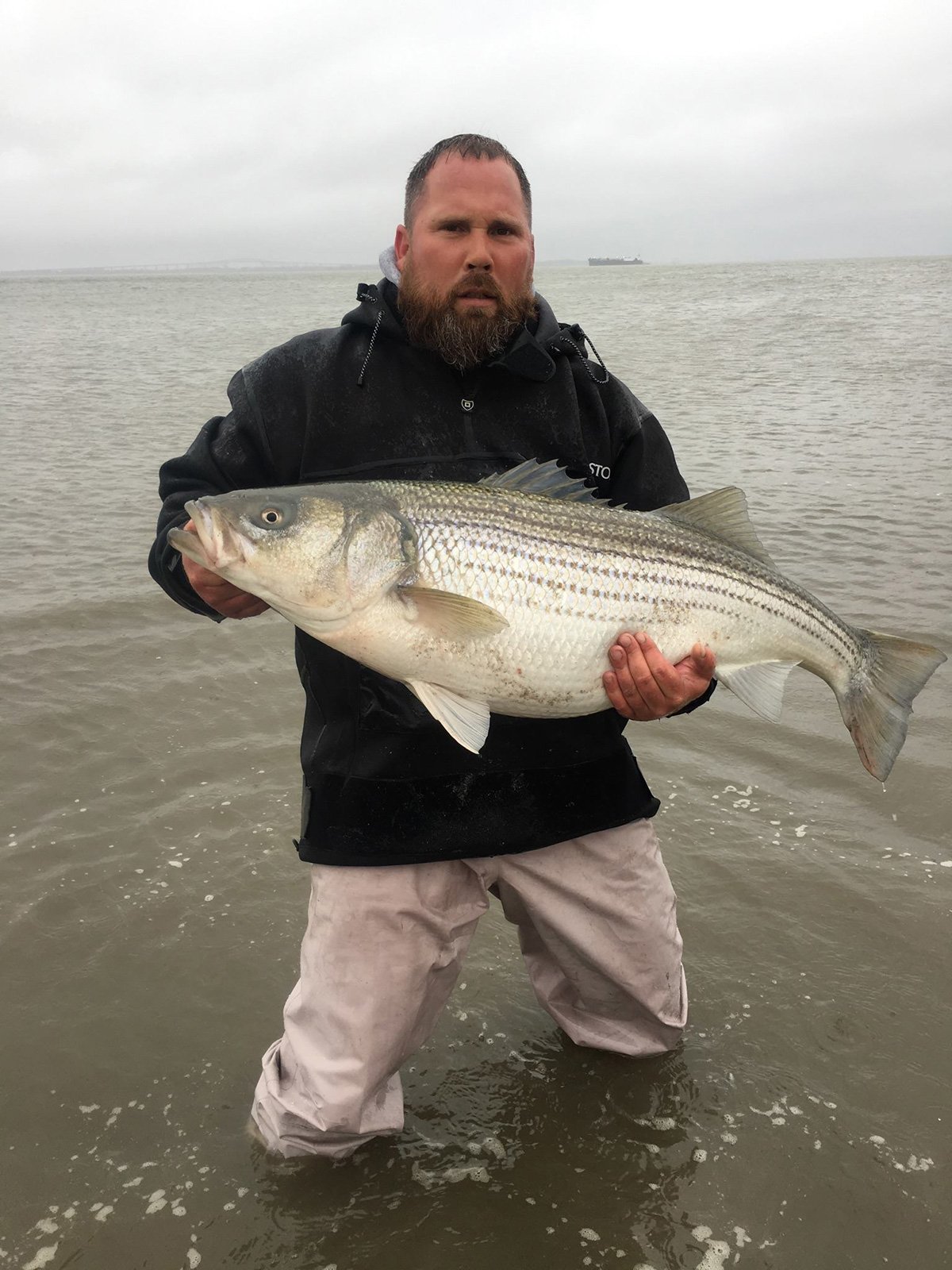
The backside bite is well underway as trophy bass move up the Delaware River during their annual run.
For the past 35 blessed years, I have had the privilege to experience some of the finest and most unique striped bass fisheries here in New Jersey; specifically I’m talking about the pre-spawn migration north in the Delaware River with large, trophy sized striped bass. And by trophy size I am referring to fish in the 40-pound plus range, with some being taken and released to well over 60 pounds during the spring run.
When March 1 arrives we have the opportunity to intercept some trophy sized striped bass as they journey up the Delaware River to their spawning areas. In 1983 I caught my first large Delaware River striper and have yet to miss a season ever since.
During this time techniques and methods have been developed to enhance our ability to locate, target and catch these fish. Along the way our tackle and strategy on catching and caring for these magnificent fish have evolved. And of course, since this is a shore based fishery these techniques have come from traditional Striper Coast surfcasting methods, though we have also borrowed some techniques from British style shore fishing and salmon fishing, while developing a few of our localized methods.
With that, here are a few of practices we’ve employed along the Delaware River for targeting pre-spawn striped bass from shore, some of which you may find completely different from approaches commonly utilized after the spawn along the outer ocean beaches.
What to Look For
At this time of year we are targeting fish that are continually on the move. They don’t stage in these areas, but they’re constantly on the move north to the freshwater spawning areas above Trenton. I have to say, there are no longer any secret spots. The first five years of fishing this area I was only allowed as a passenger and we never went nor came home the same way twice. But the types of areas to look for will be productive wherever you find them on the lower Delaware River.
What we look for when determining a productive location are very shallow mud flats. Most are flat as flat can be. These are also super shallow with depth ranging from as little as 3 feet at low tide to 6 to 8 feet at high. These areas are perfect for this style and time of fishing. They warm quickly during the day, and the mud holds the heat as the tide comes in. These fish seek outer the warmer water as they move north. Seek out these shallow mud or sand flats at all stages of the tide. These types of bottom are located throughout the lower Delaware River and all produce fish.
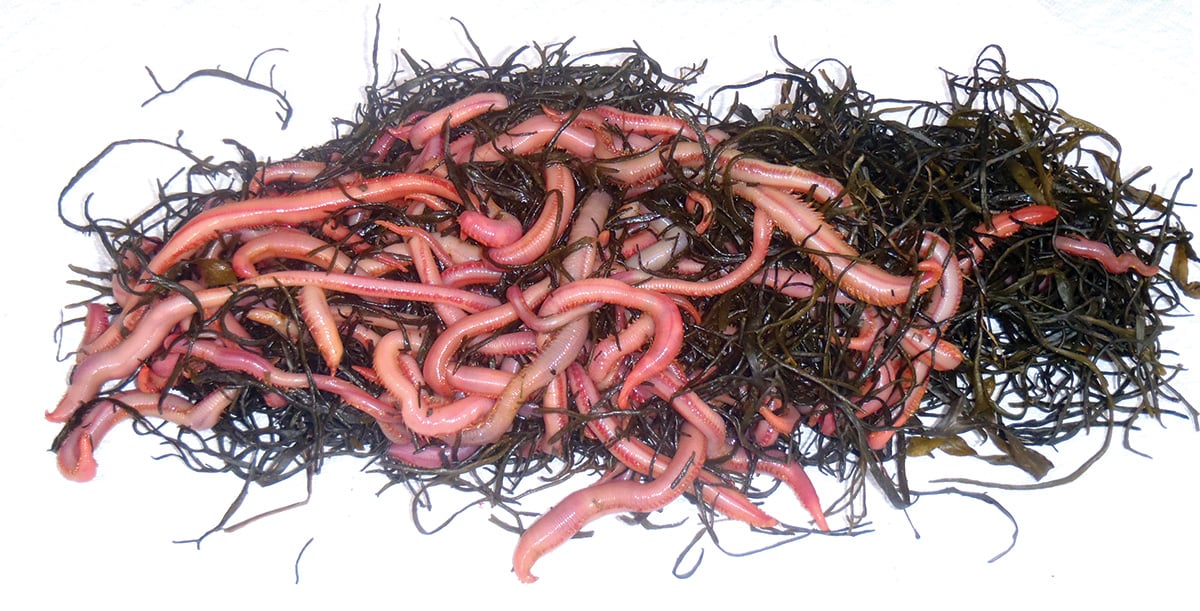
As I mentioned earlier there are some unique aspects to fishing these areas. First and foremost is the obvious lack of structure. We have little to no structure in the areas we fish along the Delaware River. Secondly there is no bait pattern present. That’s not to say there’s no bait in the river but it never comes into the areas we target. Finally, these fish never stop moving. There are no staging points. All they do is move, move, and move, which is an important thing to remember as you’re looking for productive waters.
Tides & Weather
We have caught some very large fish on all stages of the tide, however I do have some preferences. In the early part of the season starting in March I prefer a low to incoming tide that begins mid-morning. This, based on the weather that day, allows the mud to warm up and hold its heat as the tide rises. In addition to that the incoming water from Delaware Bay is warmer this time of year. I fish this tide all the way up to the top and then about an hour down.
In the early part of the season on the outgoing tide we get a tremendous cold water run-off from all the ice and snow melting up river, which can shut the bite down very quickly. As the season progresses, and the water warms and stabilizes you’ll see a change in the bite and then you can adjust your fishing accordingly.
While we have caught large fish in all weather conditions the most effective are bright sunny days, with a flat calm river and no wind. These are not the conditions you commonly think of when targeting large striped bass, but blue bird days are exceptional days to give the Delaware River a shot at trophy fishing. While we would prefer little to no wind fishing from the New Jersey side, if we have a wind, it’s best when it comes from the east. Quartering winds or winds out of the west are less desirable in these areas.
One thing I try to pass on to new anglers and any angler for that matter, don’t sit at home waiting for the perfect set of conditions. If you have time, go fishing. You will learn as much from not so good days as you will from banner days.
Tackle Selection
Your tackle becomes a critically important component when fishing this time of year and for these large pre-spawn fish. You truly have a chance of encountering a personal best fish. More important than that is this is a catch and release fishery. We want to hook, land, tag, photograph and release these fish as quickly as possible. As such, select a good quality rod that is capable of distance casting between 3 and 6 ounces and a bait. Rods should range in length form 10-1/2 to 12 feet and have enough backbone to handle a large fish in shallow water. I prefer medium fast and fast action rods.
There are many rods on the market that fit that bill; Temple Fork Outfitters has a line of shore rods that possess all the qualities mentioned. Conventional or spinning reels preform equally well, with reels by Akios, PENN, Daiwa, and many others providing you years of service. My only specific reel recommendation is in spinning reels choose one the many “long cast” spooled reel that are available as casting distance is a factor here. Whatever reel you choose make sure it’s durable, of solid construction and has a smooth drag system.
Personally, I choose braided line for its low diameter in relation to its breaking strength. However if you prefer monofilament by all means, many trophy striped bass have been and continue to be landed on mono.
This fishery, in these areas, is a 100 percent bait fishing scenario. At this time of year bloodworms are king. I’m an old school worm fishermen using blood worms exclusively. Fishing from the beginning of March until the water temperature reaches 47 degrees and above these should be your go to bait; after that clams begin to work well. After 50 to 52 degrees bunker also produces well.
Custom Rigging
When it comes to rigs, this is where we started to develop and borrow techniques from various disciplines to adapt for our type of fishing. Let’s start with the sinkers; we use exclusively sputnik style sinkers in 3 to 6 ounces. For those who are unfamiliar these are the sinkers with the grip wires. They allow you to fish with lighter weight and achieve the holding power of a much heavier conventional pyramid or frogs tongue. The wires anchor the rigs to the bottom and hold very well in the bottoms we’re fishing.
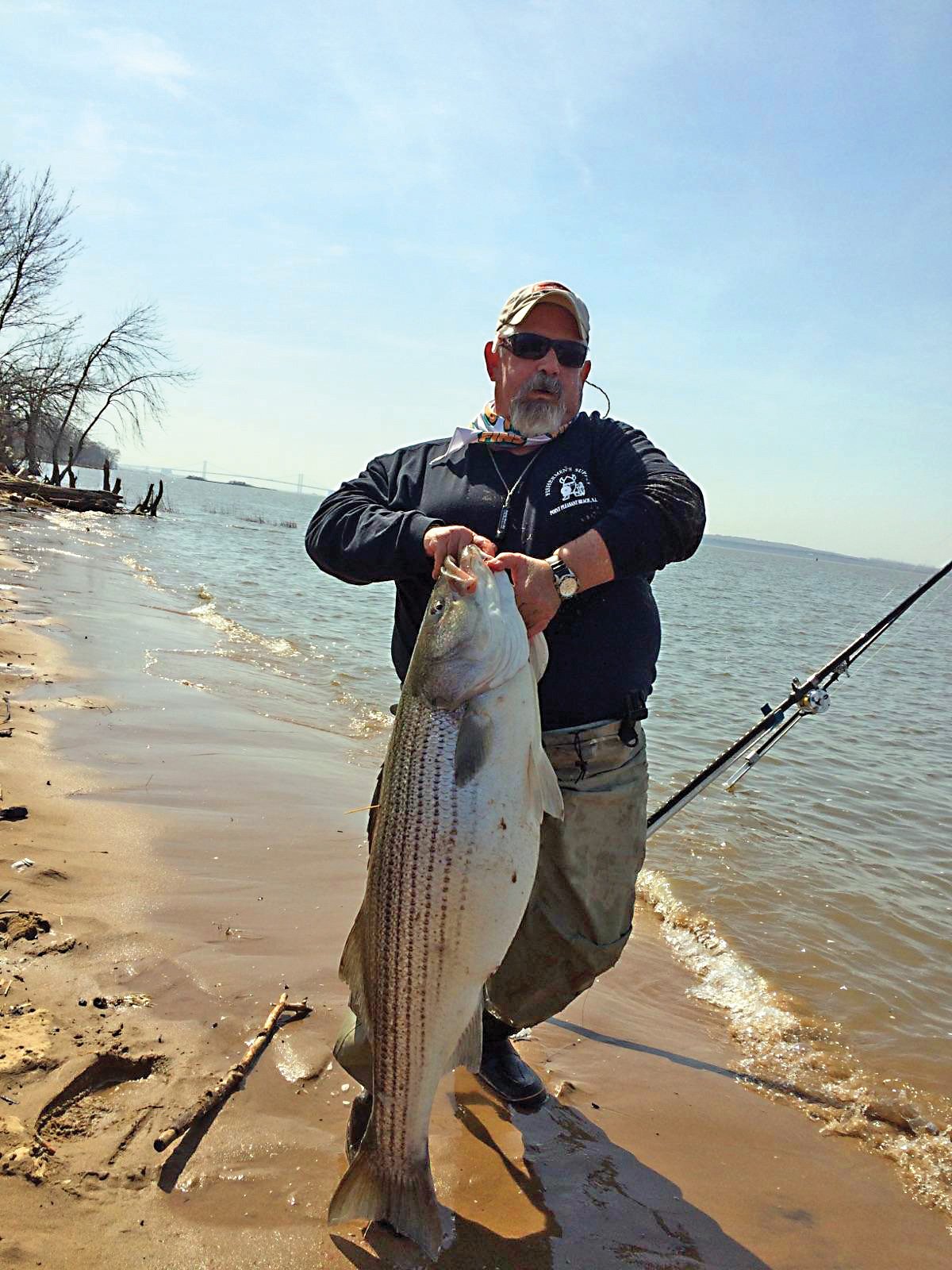
Our rigs are borrowed from the British long casting rigs and are called clip down rigs. These rigs allow you to fish a fish-finder style rig and cast it to extreme distance with the spinning associated with standard fish-finder rigs (check out www.BacklashSportfishingUSA.com).
The only other rig we use is a single dropper loop rig. This rig is tied in two configurations. Both have a 6-inch dropper loop. The first positions the loop 12 inches from the sinker and the second 16 inches. These are used in different stages of the tide. We recommend 60-pound for tying all your rigs.
Hooks are simple. We are mandated and use only in-line, non-offset circle hooks. For our worm fishing we stick to Gamakatsu in line circle in 7/0 and 8/0. For our clam and bunker fishing we use Gamakatsu in line 8/0 circle hook or 13/0 Mustad Duratin circle hooks. The thicker hook doesn’t rip out of the clam or bunker like the thinner wire of the standard hooks can.
Bait up the same way you would if out on the beach; thread bloodworms onto the hook and up along the shank, while clams and bunker can be rigged in the usual manner. Here’s another unique trick that’s helpful when white perch and micro bass become somewhat of a nuisance; it’s a tactic borrowed from the salmon fishermen who drift eggs. We take the material they use to make their bags and use it to put our worms and or clams in. You just run the hook through the bag, into the bait and out the other side; it’s the best way to keep expensive baits on the hook as long as possible.
Be patient. These are migrating fish who we are trying to intercept with our baits. The biggest challenge is seeking out the best location to set-up your ambush, but with a few of these simple tactics and techniques you can go out and enjoy this unique fishery along the Delaware River, and perhaps even catch, photo and release that fish of a lifetime!
If you have any questions about anything covered or would like more information contact the author at [email protected] or 609-820-6226.
| CLOSED SEASON – KNOW YOUR STRIPER REGS |
|---|
| From April 1 through May 31, no person may take, attempt to take, or have in possession any striped bass on the Delaware River and Bay and their tributaries from the upstream side of the Calhoun St. Bridge downstream to and including the Salem River and its tributaries. Non-offset circle hooks are required to reduce striped bass bycatch mortality while fishing with natural bait during the striped bass springtime spawning area closure within the Delaware River and its tributaries. This restriction does not apply to hook sizes smaller than size 2. |
